Collaborative Climate Action: A Pre-Requisite for More Ambitious Climate Policy
The GIZ publication “Collaborative Climate Action – A Pre-Requisite for more Ambitious Climate Policy” explains why fighting climate change and its negative impacts requires the systematic cooperation of all governmental levels in order to be successful.
Collaborative Climate Action (CCA) refers to vertical integration, or “multi-level governance”. It means that on the one side national governments, governments and authorities on provincial and regional level, and local governments all have their particular priorities and responsibilities for climate action and – on the other side – that they can only reach really ambitious climate targets when they cooperate seriously.
While this principle seems to be obvious and indispensable, it is by far not yet standard, neither in OECD countries, nor in emerging economies or in developing countries. Across the globe there are only a few country examples in which by law and in reality all levels of government are recognised for and sufficiently enabled to providing relevant contributions to mitigating greenhouse gas (GHG) emissions and adapting to climate change.
Why is the purposeful cooperation of all levels so relevant and what are the specific aspects of “CCA”? The key statements of the study include in short:
The Why
- If all public actors pull together their responsibilities, tasks, budgets, experts, contacts, and cooperation partners in the same direction, they can reach much more together than one actor alone.
- At the same time, they avoid contradictory incentives and can save enormous amounts of money, staff, and time when supporting each other mutually.
- Thus, CCA contributes directly to the coherence of climate policy – from the international to the local level, to action at the spot.
This cooperation is of particular relevance for the urgently needed mitigation of GHG emissions in urban areas, for different reasons: it is in cities that we are specifically affected and endangered by climate change and at the same time that we find innovative actors.
While national and regional governments can regulate and achieve around 35 per cent and local governments can contribute around 28 per cent of the mitigation potential, most of the CO2 reduction possibilities need joint and coordinate action of all governmental levels. The results of the report Climate Emergency – Urban Opportunity are a strong argument for cooperation.
The How
- Collaborative Climate Action (CCA) can be sporadic, voluntary, or temporary. It can unfold its real strength when being politically intended, well- organised, and including a long-term perspective. Equally relevant are the definition of responsibilities in constitutions, laws and rules for cooperation flows, and predictable processes.
- Further success factors include: joint basic values and principles, steering CCA along rules, fair process management, engagement of supportive personalities, fact-based decision making, learning capabilities of the political system, and cooperation with further partners
- In addition, CCA needs the trust, courage, and patience of people and institutions, wisely established ways of cooperation and – joint successes of climate action.
While CCA is defined by vertical cooperation, horizontal cooperation – for example between ministries, sectors, and thematic areas – is relevant for successful climate policy as well, as is the inclusion of civil society, economy, academia, and media.
The Relevance of the Municipal Level
The relevance of national governments is widely accepted. To strengthen CCA, it is most needed to strengthen the sub-national level, cities, and regions. Government levels can only fruitfully cooperate if local governments are able and enabled to act.
It must be repeated: cooperation does not simply mean that a lower level is just implementing decisions by a higher level. Sub-national governments and authorities must be truly included in the definition of targets and the development of instruments. Only in this way can cities and regions influence national climate targets and bring in their expertise on how to best implement such targets.
When implementing climate targets, each government level must mobilise its particular potential. Transportation is a good example. Regulation on fuels or rules for aviation and shipping must be introduced by the national government. Designing sustainable mobility on the spot, however, requires action of municipalities, metropolitan areas, or regions. They must be given responsibilities, authority, and means for their public transport management, for restriction of car access and parking, speed limits, and setting up “streets for all”, just to give examples.
Of course, the indentation of responsibilities of all levels is not a new idea. Local governments have requested this for decades, and many international associations of cities and regions have advocated this vis-á-vis their governments and at the UN climate negotiations. They point to the fact that only “strong cities”, those with competences, financial means, staff, data & knowledge, can contribute their part to mitigate and adapt. However, such “strong cities” are in many countries not the norm.
To make CCA an available cooperation mode worldwide nevertheless, development cooperation should include the basics of CCA, explain its advantages, and make it conditional for project finances and infrastructure investments.
When and How to Start?
To make CCA a reality, it is necessary to express goals explicitly and to decide upon an implementation process. The lists some good starting points for CCA: one is the UN climate process, which provides an excellent framework through its Nationally Determined Contributions (NDCs) and the required Long-term Strategies (LTS).
Cities and regions have proposed that the UN climate conference set to take place in Glasgow in November 2021 adopts the motto “Multilevel Action COP”. That would make climate cooperation a subject of the governmental negotiations as well as send an invitation to regions and local governments to join and co-create respective proposals.
Eventually, good cooperation of governmental levels will improve the climate policies of all countries. In addition to exercising a “daily culture of cooperation”, each country offers strategic moments as ideal entry points for starting, intensifying, or improving cooperation.
